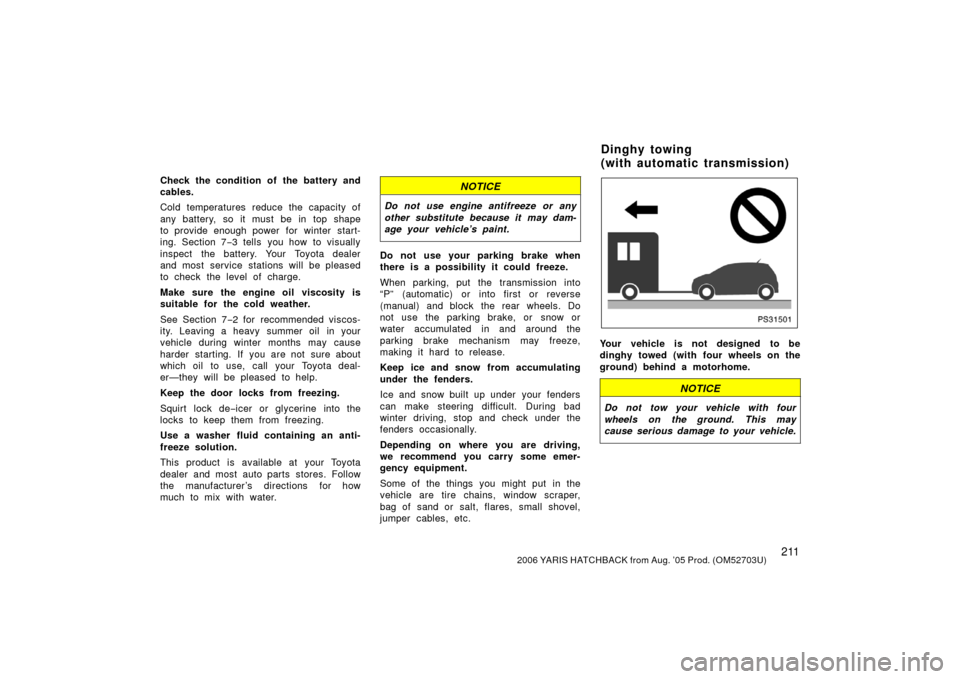Page 204 of 312

1972006 YARIS HATCHBACK from Aug. ’05 Prod. (OM52703U)
Temperature A, B, C—T he tem per a-
ture grades are A (the highest), B,
and C, representing the tire’s resis-
tance to the generation of heat and
its ability to dissipate heat when
tested under controlled conditions on
a specified indoor laboratory test
wheel. Sustained high temperature
can cause the material of the tire to
degenerate and reduce tire life, and
excessive temperature can lead to
sudden tire failure. The grade C cor-
responds to a level of performance
which all passenger car tires must
meet under the Federal Motor Vehicle
Safety Standard No. 109. Grades B
and A represent higher levels of per-
formance on the laboratory test wheel
than the minimum required by law.
Warning: The temperature grades for
this tire are established for a tire that
is properly inflated and not over-
loaded. Excessive speed, underinfla-
tion, or excessive loading, either sep-
arately or in combination, can cause
heat buildup and possible tire failure.
Page 206 of 312

1992006 YARIS HATCHBACK from Aug. ’05 Prod. (OM52703U)
Ti r e relat ed ter mMeaning
Production options weight
the combined weight of those installed regular production options weighing over
2.3 kg (5 lb.) in excess of those standard items which they replace, not pre-
viously considered in curb weight or accessory weight, including heavy duty
brakes, ride levelers, roof rack, heavy duty battery, and special trim
Vehicle capacity weight
(Total load capacity)the rated cargo and luggage load plus 68 kg (150 lb.) times the vehicle’s desig-
nated seating capacity
Intended outboard sidewall
(A) the sidewall that contains a whitewall, bears white lettering or bearsmanufacturer, brand, and/or model name molding that is higher or deeper
than the same molding on the other sidewall of the tire, or
(B) the outward facing sidewall of an asymmetrical tire that has a particular side that must always face outward when mounted on a vehicle
Occupant distributiondistribution of occupants in a vehicle as specified in the third column of Table
1 that follows
Rima metal support for a tire or a tire and tube assembly upon which the tire beads
are seated
Rim diameter (Wheel diameter)nominal diameter of the bead seat
Rim size designationrim diameter and width
Rim type designationthe industry of manufacturer ’s designation for a rim by style or code
Rim widt hnominal distance between rim flanges
Vehicle maximum load on the tirethe load on an individual tire that is determined by distributing to each axle
its share of the maximum loaded vehicle weight and dividing by two
Page 212 of 312
2052006 YARIS HATCHBACK from Aug. ’05 Prod. (OM52703U)
All season tires, however, do not have
adequate traction performance
compared with snow tires in heavy or
loose snow. Also, all season tires fall
short in acceleration and handling
performance compared with summer
tires in highway driving.
The details about how to distinguish
summer tires from all season tires are
described on page 191.
CAUTION
�Do not mix summer and all sea-
son tires on your vehicle as
this can cause dangerous han-
dling characteristics, resulting
in loss of control.
� Do not use tires other than the
manufacturer’s designated
tires, and do not mix tires or
wheels of the sizes different
from the originally equipped
tires and wheels as this can
cause dangerous handling
characteristics, resulting in
loss of control.
Page 215 of 312

2082006 YARIS HATCHBACK from Aug. ’05 Prod. (OM52703U)
Before starting the engine
1. Check the area around the vehicle be-fore entering it.
2. Adjust seat position, seatback angle, head restraint height and steering
wheel angle.
3. Adjust inside and outside rear view mirrors.
4. Lock all doors.
5. Fasten seat belts. Once you turn the ignition key to “START”
position and release it, the cranking hold
function continues to crank the engine in
“ON” position until it starts.
The function stops cranking the engine
after about 20 seconds maximum if the
engine has not started yet. When you
crank the engine again, wait a few sec-
onds and restart it.
If you hold the key in “START” position,
the function will keep cranking. 1. Apply the parking brake firmly.
2. Turn off unnecessary lights and acces-
sories.
3. Manual transmission: Press the clutch
pedal to the floor and shift the trans-
mission into neutral. Hold the clutch
pedal to the floor until the engine is
started. A starter safety device will pre-
vent the starter from operating if the
clutch pedal is not fully depressed.
Automatic transmission: Put the se-
lector lever in “P”. If you need to re-
start the engine while the vehicle is
moving, put the selector lever in “N”.
A starter safety device will prevent the
starter from operating if the selector
lever is in any drive position.
4. Automatic transmission only: De-
press the brake pedal and hold it to
the floor until driving off.
How to start the engine—
—Cranking hold function (a) Before cranking
Page 216 of 312

2092006 YARIS HATCHBACK from Aug. ’05 Prod. (OM52703U)
(b) Starting the engine
Before starting the engine, be sure to
follow the instructions in “(a) Before
cranking”.
Normal starting procedure
The multiport fuel injection system/sequen-
tial multiport fuel injection system in your
engine automatically controls the proper
air−fuel mixture for starting. You can start
a cold or hot engine as follows:
With your foot off the accelerator pedal,
crank the engine by turning the key to
“START”. Release it when the engine
starts.
Engine should be warmed up by driving,
not in idle. For warming up, drive with
smoothly turning engine until engine cool-
ant temperature is within normal range.
If the engine stalls...
Simply restart it, using the correct proce-
dure given in normal starting.
If the engine will not start...
See “If your vehicle will not start” on page
222 in Section 4.NOTICE
� Do not race a cold engine.
� If the engine becomes difficult to
start or stalls frequently, have the
engine checked immediately.
�Always slow down in gusty crosswinds.
This will allow you much better control.
�Drive slowly onto curbs and, if pos-
sible, at a right angle. Avoid driving
onto high, sharp− edged objects and
other road hazards. Failure to do so
can lead to severe tire damage such
as a tire burst.
Drive slowly when passing over bumps
or travelling on a bumpy road. Other-
wise, the impact could cause severe
damage to the tires and/or wheels.
�When parking on a hill, turn the front
wheels until they touch the curb so
that the vehicle will not roll. Apply the
parking brake, and place the transmis-
sion in “P” (automatic) or in first or
reverse (manual). If necessary, block
the wheels.
Tips for driving in various
conditions
Page 218 of 312

2112006 YARIS HATCHBACK from Aug. ’05 Prod. (OM52703U)
Check the condition of the battery and
cables.
Cold temperatures reduce the capacity of
any battery, so it must be in top shape
to provide enough power for winter start-
ing. Section 7−3 tells you how to visually
inspect the battery. Your Toyota dealer
and most service stations will be pleased
to check the level of charge.
Make sure the engine oil viscosity is
suitable for the cold weather.
See Section 7 −2 for recommended viscos-
ity. Leaving a heavy summer oil in your
vehicle during winter months may cause
harder starting. If you are not sure about
which oil to use, call your Toyota deal-
er—they will be pleased to help.
Keep the door locks from freezing.
Squirt lock de −icer or glycerine into the
locks to keep them from freezing.
Use a washer fluid containing an anti-
freeze solution.
This product is available at your Toyota
dealer and most auto parts stores. Follow
the manufacturer ’s directions for how
much to mix with water.NOTICE
Do not use engine antifreeze or any
other substitute because it may dam-
age your vehicle’s paint.
Do not use your parking brake when
there is a possibility it could freeze.
When parking, put the transmission into
“P” (automatic) or into first or reverse
(manual) and block the rear wheels. Do
not use the parking brake, or snow or
water accumulated in and around the
parking brake mechanism may freeze,
making it hard to release.
Keep ice and snow from accumulating
under the fenders.
Ice and snow built up under your fenders
can make steering difficult. During bad
winter driving, stop and check under the
fenders occasionally.
Depending on where you are driving,
we recommend you carry some emer-
gency equipment.
Some of the things you might put in the
vehicle are tire chains, window scraper,
bag of sand or salt, flares, small shovel,
jumper cables, etc.PS31501
Your vehicle is not designed to be
dinghy towed (with four wheels on the
ground) behind a motorhome.
NOTICE
Do not tow your vehicle with four
wheels on the ground. This may
cause serious damage to your vehicle.
Dinghy towing
(with automatic transmission)
Page 219 of 312

2122006 YARIS HATCHBACK from Aug. ’05 Prod. (OM52703U)
PS31502
Your vehicle can be dinghy towed (with
four wheels on the ground) from the
front behind a motorhome.
CAUTION
Dinghy towing requires special equip-
ment and accessories. Please refer to
your service outlet of the motorhome
manufacture for the recommended
equipment.
NOTICE
Dinghy towing does not eliminate the
possibility of damage to your vehicle.
DINGHY TOWING TIPS
Before dinghy towing, be sure to ob-
serve the following in order to reduce
the damage to your vehicle.1. Put the shift lever in neutral.
2. Turn the ignition switch to the “ACC” position. Make sure the audio is turned
off and any item is not plugged into
the power outlet.
NOTICE
To avoid the locking of the steering
wheel, turn the ignition switch to the
“ACC” position.
3. Release the parking brake.
After dinghy towing, let the engine idle for
more than 3 minutes before driving the
vehicle.
PS31503
NOTICE
Do not tow your vehicle from the
rear. This may cause serious damage
to your vehicle.
Dinghy towing
(with manual transmission)
Page 220 of 312

2132006 YARIS HATCHBACK from Aug. ’05 Prod. (OM52703U)
QS31501
Toyota does not recommend towing a
trailer with your Toyota. Toyota also
does not recommend the installation of
a tow hitch or the use of a tow hitch
carrier for a wheelchair, scooter, bi-
cycle, etc. Your Toyota is not designed
for trailer towing or for the use of tow
hitch mounted carriers.
Trailer towing (for Canada)
Your vehicle is designed primarily as a
passenger−carrying vehicle. Towing a
trailer will have an adverse effect on
handling, performance, braking, durability
and driving economy (fuel consumption,
etc.). Your safety and satisfaction depend
on the proper use of correct equipment
and cautious driving habits. For your
safety and the safety of others, you must
not overload your vehicle or trailer. Toyota
warranties do not apply to damage or
malfunction caused by towing a trailer for
commercial purposes. Ask your local
Toyota dealer for further details before
towing.
WEIGHT LIMITS
Before towing, make sure the total trailer
weight, gross vehicle weight, gross axle
weight and trailer tongue load are all with-
in the limits.
The total trailer weight and tongue load
can be measured with platform scales
found at a highway weighing station, build-
ing supply company, trucking company,
junk yard, etc.
PS21504
CAUTION
�The total trailer weight (trailer
weight plus its cargo load) must
not exceed 318 kg (700 lb.). Exceed-
ing this weight is dangerous.
Trailer towing (except for
Canada)